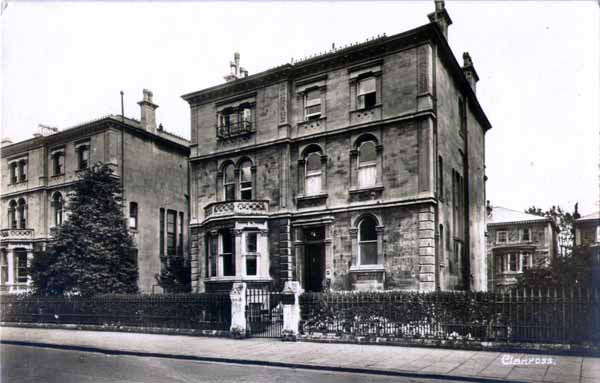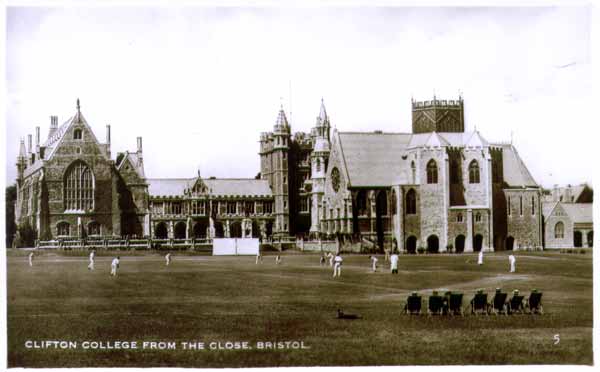
Bristol UK Postcards
Clanross Hotel

Clanross Hotel
This unposted postcard has the printed text...
Photo: Bromhead, Clifton
"Clanross"
Victoria Square
Clifton, Bristol
Tel: 2181
Although unposted this postcard does have a hand-written message on it...
The Hotel Clanross where we + Ira stayed while in Bristol, Eng. The landlady drank and fell down the stairs twice while we were there. I made some apple pies for them while I was there.
E.C.C.
Clifton College

Clifton College
This unused, enbossed, postcard has the printed text...
Raphael Tuck & Sons "Heraldic" Postcard Series 159
Designed in England. Chromographed in Bavaria
Tuck issued both the "Heraldic" and "United Kingdom" series of postcards in 1902 / 1903.

Clifton College from The Close
This unused postcard has the printed text...
5
Rxcel Series
This is a Real Photograph
Printed in England
Founded in founded in 1862, the college buildings were designed by architect Charles Hansom. His first design was for Big School and a proposed dining hall. Only the former was actually built and a small extra short wing was added in 1866 – this is what now contains the Marshal’s office and the new staircase into Big School. The Big School can be seen on the left in the poscard image. The college's Marshal is responsible for discipline.
Source: Wikipedia
Clifton Down Hotel

Clifton Down Hotel
This postcard, with an unreadable date stamp, has the printed text...
Clifton Down Hotel
Clifton, Bristol
Telephone:
Visitors 3111
Management 550
Telegrams "Suspension Bristol"
This fanciful postcard shows Clifton Down Hotel which was completed in 1865, shortly after the opening of Brunel's world renowned Clifton Suspension Bridge, which it overlooks. Now known as Bridge House, this building was converted into luxurious apartments in 2007. A 1905 advertisement for the hotel described it as having "a lavatory on every floor." Situated close to the Downs, Clifton Suspension Bridge and the Observatory, which are all depicted on the card, the owner of the hotel complained that the sheep, which were allowed to graze on the Downs until 1924, disturbed his guests. In 1939, the building was requisitioned by the army and converted into offices.
Clifton Rocks Railway

Clifton Rocks Railway
This unused postcard has no other printed text and shows the lower, Hotwells, entrance.
The Clifton Rocks Railway was an underground funicular railway in Bristol, linking Clifton at the top to Hotwells and Bristol Harbour at the bottom of the Avon Gorge in a tunnel cut through the limestone cliffs. The upper station is close to Brunel's famous Clifton Suspension Bridge and is located adjacent to the former Grand Spa Hotel (now the Avon Gorge Hotel).
The lower station was opposite the paddle steamer landing ferries in Hotwells, Hotwells railway station of the Bristol Port Railway and Pier, a terminus of Bristol Tramways and the Rownham ferry enabling connections across the river Avon. Construction of the railway was funded by the publisher George Newnes, also proprietor of the Lynton and Lynmouth Cliff Railway, and as at Lynton and Lynmouth the engineer was George Croydon Marks.
It opened on 11th March 1893, but was never a great success; in 1912 it was sold to Bristol Tramways, but it continued to struggle and closed on 1 October 1934. The railway had a length of 450 feet (137 m), overcoming a vertical distance of 200 feet (61 m) at a gradient of about 1 in 2.2 (45%). There were four cars in two connected pairs, essentially forming two parallel funicular railways, each running on 38 inch (965 mm) narrow gauge tracks. The system was operated by gravity, with water ballast being let into the cars at the top station and out at the bottom, and an oil- or gas-burning pump returning the water to the top of the system.
During the Second World War blast walls were installed in the tunnel, which was used as offices by BOAC, as a relay station by the BBC (who also constructed an emergency studio there, though it was never put into use), and as an air-raid shelter. The BBC continued to use parts of the tunnel until 1960.
This page created 30th August 2009, last modified 7th February 2010